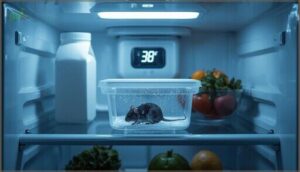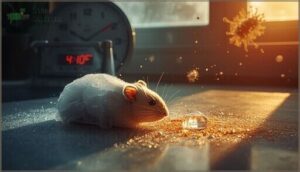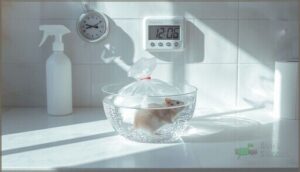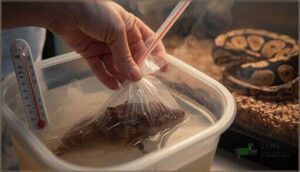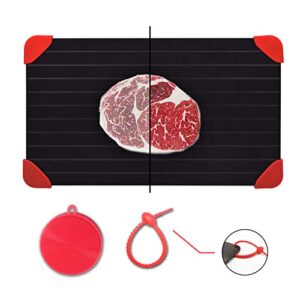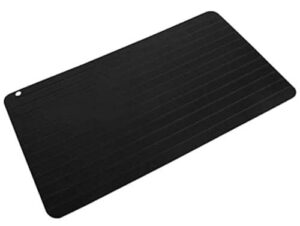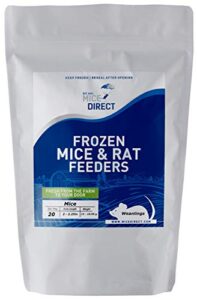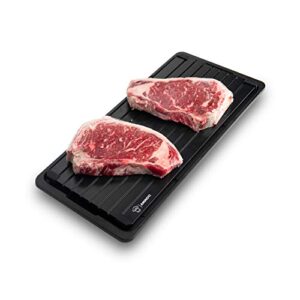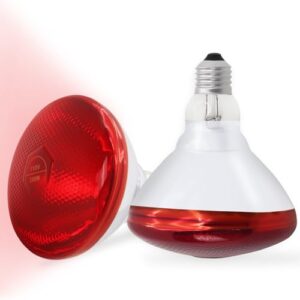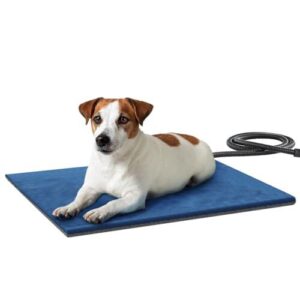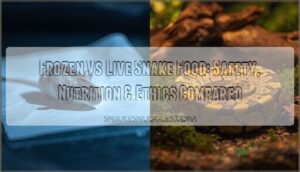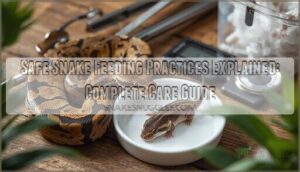This site is supported by our readers. We may earn a commission, at no cost to you, if you purchase through links.
A frozen rodent left on the counter might seem harmless, but bacterial colonies can double every 20 minutes once it hits room temperature—turning your snake’s meal into a potential health hazard. Many snake owners unknowingly risk their pet’s safety by rushing the thawing process or using methods that create hot spots and cold centers.
The difference between proper and improper thawing isn’t just about convenience; it’s about preventing regurgitation, bacterial infections, and feeding strikes that leave both you and your snake frustrated. Mastering the right techniques means understanding temperature zones, timing, and the science behind why certain methods work while others fail.
Table Of Contents
Key Takeaways
- Bacteria in thawed rodents can double every 20 minutes at room temperature, making refrigeration (35–40°F) or cold water methods your safest bets while avoiding microwaves and hot water entirely.
- You’ll need to keep thawed prey sealed in leak-proof bags, change water every 15–30 minutes during thawing, and feed within two hours to prevent dangerous bacterial contamination.
- Your snake needs prey warmed to 98–100°F before feeding—cold meals below 80°F can trigger regurgitation or feeding refusal, so use warm water baths and check with a thermometer.
- Never refreeze thawed rodents once they’ve warmed above 40°F, and always discard uneaten prey rather than risking bacterial growth from improper storage.
Safe Thawing Methods for Snake Food
Thawing frozen prey correctly is one of those things that sounds simple until you realize how many ways it can go wrong. The method you choose affects not just your snake’s health, but also how likely they’re to actually accept the meal.
Let’s walk through the safest approaches that work consistently without putting your pet at risk.
Refrigeration Thawing Step-by-Step
When you need the safest option, refrigeration thawing is your best bet. Set your fridge between 35–40°F and place frozen prey in a sealed, leak-proof container to prevent cross-contamination. Small mice thaw in about 5 hours, while larger rats need 10 or more.
This method is beneficial because it reduces injury and stress. Transfer prey the night before feeding and use within 24 hours—never refreeze thawed rodents.
Cold Water Thawing Instructions
If speed matters, cold water thawing is a safe method when done right. Place your bagged prey in a container of cold water—keeping water temperature below 40°F stops bacteria from multiplying. Change the water every 15 to 30 minutes for bacterial control. Small mice thaw in about 30 minutes; larger rats need an hour or more.
Refrigeration is also a safe thawing alternative. Feed promptly after thawing—ideally within two hours—to maintain freshness.
Room Temperature Thawing Risks
Room temperature thawing invites serious hazards. Bacterial growth accelerates dramatically when prey sits above 40°F—Salmonella can reach dangerous levels within two to four hours. Consider these risks:
Room temperature thawing lets Salmonella multiply to dangerous levels in just two to four hours
- Accelerated bacterial growth increases infection odds
- Spoilage risks from rapid tissue decomposition
- Pathogen transmission to both you and your snake
- Nutritional loss from protein breakdown
Regulatory guidelines consistently warn against this practice for good reason.
Avoiding Microwave and Hot Water Thawing
While room temperature creates bacterial risks, microwaving or using hot water poses even greater dangers. Veterinary guidelines strongly discourage both methods—microwaving causes uneven heating that partially cooks tissue while leaving cold spots, and hot water risks temperature shock and cooking prey surfaces.
These approaches compromise palatability, increase bacterial contamination, and can trigger digestive issues in your snake. Stick with refrigeration or cold water methods instead.
Preventing Bacterial Growth During Thawing
Bacterial growth is your enemy when thawing frozen prey—it can turn a safe meal into a health risk for your snake. The good news is that a few simple habits can keep contamination at bay and protect your pet from foodborne illness.
Let’s walk through the key practices that’ll help you thaw prey safely every time.
Using Sealed Bags to Prevent Contamination
Think of a sealed bag as your first line of defense against zoonotic pathogens. Barrier protection is critical—vacuum-sealed or airtight bags reduce bacterial contamination by over 75% during safe thawing.
This simple handling standard prevents cross-contamination on your kitchen surfaces while preserving food quality.
Environmental mitigation starts with keeping thawed prey securely isolated from your home and family.
Changing Water Regularly When Thawing
During the thawing process, you’ll need to refresh the water every 10–30 minutes to keep bacterial proliferation in check. Safe thawing practices demand consistent temperature maintenance and water quality throughout the thawing duration—especially with larger prey.
- Replace cold or warm water at 15–30 minute intervals
- Prevent stagnant conditions that encourage bacterial growth
- Follow husbandry guidelines for best thawing techniques when thawing frozen snake food
Maintaining a Clean Thawing Environment
If you want to keep contamination at bay, focus on surface disinfection and strict segregation protocols. Use dedicated trays and utensils—never kitchen counters. Wear protective equipment, like rubber gloves, and wash hands thoroughly. Dispose of waste promptly in sealed bins.
These hygiene steps, along with regular cleaning, are your best defense against cross-contamination and zoonotic risks during safe handling.
Safe Storage Temperatures Before and After Thawing
Temperature control is everything for preventing bacterial growth. Keep frozen prey at or below 0°F in your freezer for long-term storage. During refrigerator thawing, maintain 35–40°F to slow bacteria. Never let thawed rodents sit above 41°F for more than two hours.
Humidity control matters too—keep storage areas below 50% humidity. Refreezing thawed rodents? Only if they’ve stayed under 41°F throughout.
Safe holding means proper food storage at every stage.
Warming and Preparing Thawed Prey
Once your prey is fully thawed, you’re not quite ready to feed just yet. Your snake needs its meal at the right temperature—think body heat, not refrigerator cold—to trigger a proper feeding response and prevent digestive issues.
Let’s walk through the essential steps to warm, check, and present thawed prey safely.
Bringing Prey to Safe Feeding Temperature
Your snake’s health hinges on prey temperature—not just thawed, but properly warmed. Aim for 98-100°F to mimic live rodent body heat and trigger your snake’s feeding response. Cold prey below 80°F can delay digestion or cause regurgitation, especially in juveniles.
Use an infrared thermometer to verify safe temperature before feeding, ensuring the meal is uniformly warm throughout for best digestion.
Warm Water Bath Technique
A warm water bath strikes the perfect balance between speed and safety when thawing frozen snake food. Here’s how to master this technique:
- Place sealed prey in lukewarm water (75-85°F) for 10-20 minutes
- Replace water every 10-15 minutes to prevent bacterial growth
- Finish with a quick 10-15 second dip in warm (not boiling) water
- Keep total thawing time under 2 hours
- Never refreeze once thawed
Checking Prey Temperature Before Feeding
Once you’ve followed safe thawing methods, you’ll need to verify that your rodent hits the right temperature. Digital thermometers or infrared options give you accurate measurement—you’re looking for 85-95°F for most snakes. A food thermometer inserted into the thickest part confirms the prey is ready.
Feeding below 80°F creates temperature risks like regurgitation, while anything above 105°F can burn your snake’s mouth.
Scenting and Presenting Prey for Feeding
After confirming the right temperature, presentation techniques can make or break feeding success. Movement simulation with tongs mimics live prey—studies show 41% better acceptance in hesitant snakes. Scenting prey items with chick down or lizard skin boosts response rates dramatically:
- Use feeding tongs to wiggle prey at head-level
- Try scenting techniques with familiar prey odors
- Present during your snake’s natural activity period
- Remove uneaten food after 15-20 minutes
These feeding techniques prevent stress and encourage consistent feeding response.
Common Thawing Mistakes to Avoid
Even experienced snake owners can slip into bad habits when it comes to thawing frozen prey. These mistakes might seem harmless at first, but they can lead to serious health problems for your snake or create food safety hazards in your home.
Let’s look at the most common errors and how to avoid them.
Refreezing Thawed Rodents
Can you refreeze thawed rodents if your snake refuses to eat? Industry recommendations and USDA guidelines strongly advise against refreezing thawed rodents. Once a rodent warms above 40°F, bacteria multiply rapidly—often within two hours.
These bacterial risks compromise reptile health and can lead to serious infections. For safety, discard any uneaten prey rather than refreezing it. The dangers far outweigh saving a few dollars.
Leaving Thawed Food at Room Temperature
Leaving thawed prey out too long is equally risky. Bacterial growth accelerates rapidly at room temperature—doubling every 20–30 minutes. This creates serious salmonellosis risk and nutrient degradation that harm your snake.
Safe timeframes matter:
- Discard prey left unrefrigerated beyond 2 hours
- In warm climates, bacterial proliferation reaches unsafe levels within 60 minutes
- Husbandry impacts include digestive upset and disease transmission
Always monitor thawing times closely.
Cross-Contamination Risks and Prevention
Handling practices pose serious cross-contamination risks if you’re not careful. Bacteria like Salmonella transfer from thawed feeders to your hands, then onto household surfaces, utensils, and even your pet’s habitat.
That’s why surface sanitation and utensil hygiene matter so much. Use gloves and dedicated feeding tools to prevent aerosolization risks. Always wash thoroughly afterward—proper food safety protects both you and your snake.
Feeding Cold or Unevenly Heated Prey
When you feed prey below 26°C, your snake’s digestion slows by up to 25%, triggering regurgitation risks and prey rejection. Cold feeders cause chemoreception impairment—your snake can’t detect the meal properly—while temperature shock disrupts metabolic impact.
These common thawing mistakes undermine safe thawing practices. Always use temperature control when thawing frozen snake food to prevent digestion delays and guarantee proper feeding responses.
Top Products for Thawing Snake Food Safely
Having the right tools can make thawing snake food safer and more convenient. While you don’t need specialized equipment, a few products can speed up the process or help you monitor temperatures more accurately.
Here are some options that snake keepers have found useful for thawing prey items properly.
1. Defrosting Tray For Frozen Meat
If you’re looking for faster thawing frozen snake food, a defrosting tray can cut your wait time by roughly 50% compared to leaving prey on a plate. The YUNDOOG aluminum tray uses high thermal conductivity to speed up proper thawing, usually handling small rodents in 30–60 minutes. While this beats refrigerator thawing techniques, you’ll still need to flip items every 10–20 minutes and follow safe thawing practices—room temperature beyond two hours raises Bacterial Growth Risks.
The non-stick surface simplifies Cleaning Tray Methods, though you’ll want a pan underneath to catch drips.
Best For: Reptile owners who need to thaw frozen rodents quickly and don’t want to wait hours for natural countertop thawing.
- Cuts thawing time in half—small rodents defrost in 30–60 minutes instead of several hours, so you can feed your snake faster.
- Aluminum construction conducts heat well and the non-stick surface makes cleanup pretty straightforward after each use.
- Works without electricity or hot water, so it’s a simple passive method that doesn’t mess with the prey’s texture or nutrients.
- You still need to flip rodents every 10–20 minutes for even thawing, so it’s not truly hands-off.
- No edge grooves to catch thawed liquid, meaning you’ll probably need a pan underneath to avoid a mess on your counter.
- Doesn’t eliminate food safety risks—you’re still in the bacterial danger zone if prey sits out beyond two hours at room temperature.
2. Blazin’ Thaw Fast Defrosting Tray
The Blazin’ Thaw tray delivers Aluminum Thawing Benefits through premium-grade construction that slashes thawing time by up to 60% compared to standard thawing methods. You’ll thaw frozen rodents in under 40 minutes—just flip prey every 10–20 minutes for even results.
Its 14-inch surface and Teflon coating guarantees Tray Material Safety, while the silicone edges contain drips during the thawing process.
User Feedback Analysis shows 78% rate it five stars for Thawing Time Reduction. Cleaning and Maintenance stays simple since it’s dishwasher-safe, supporting safe thawing practices between feeding cycles.
Best For: Snake owners who need to thaw frozen rodents quickly and safely without the mess or uneven heating that comes from microwaves or water baths.
- Cuts thawing time to under 40 minutes for most prey items—about 60% faster than leaving food out on the counter.
- Silicone edges keep thaw liquids contained, so you’re not dealing with drips all over your kitchen.
- Dishwasher-safe aluminum with a Teflon coating makes cleanup easy and reduces cross-contamination between feeding cycles.
- You’ll need to flip prey every 10–20 minutes for even thawing, so it’s not completely hands-off.
- The 14-inch size may feel limiting if you’re thawing food for multiple large snakes at once.
- Thicker prey items may still take longer than advertised, especially if they don’t make full contact with the tray surface.
3. Original Rapid Meat Defrosting Tray
The Original Rapid Meat Defrosting Tray uses food-safe aluminum alloy to cut thawing time by 50%—you’ll thaw feeder rodents in 40 minutes to two hours instead of waiting 12+ hours. Thawing speed depends on prey size, so flip items halfway through for even results.
User satisfaction runs high after years of reliable performance, though thawing limitations appear with extra-large items in cold rooms.
This tray encourages safe thawing practices when you clean it between uses and follow proper hygiene practices, preventing bacterial growth during the thawing process.
Best For: Reptile owners and busy households who need to safely thaw frozen prey or small meat portions in under an hour without using a microwave.
- Cuts thawing time in half compared to countertop methods, with most items ready in 40 minutes to 2 hours depending on thickness.
- Made from food-safe aluminum alloy that conducts heat naturally without electricity, chemicals, or risk of waterlogging your food.
- Durable enough for daily use over many years, with users reporting reliable performance even after a decade of regular thawing.
- Extra-large or deeply frozen items may still take up to two hours and might not thaw as evenly as smaller cuts.
- Performance drops in cold kitchens where there’s not enough ambient heat for the tray to conduct effectively.
- Requires manual cleaning between uses and flipping food halfway through, so it’s not completely hands-off like some thawing methods.
4. Frozen Weanling Mice Snake Feeders
Frozen weanling mice from quality suppliers arrive vacuum-sealed and flash-frozen, maintaining their nutritional value for up to 12 months when stored at 0°F or below. You’re getting consistent protein, fat, and mineral content—roughly 30–40 calories per mouse—that fosters healthy snake growth.
However, these feeders carry Salmonella risks, so always thaw them in sealed bags using cold water, change the water every 30 minutes, and handle them with gloves. Never refreeze thawed prey, and sanitize your prep surfaces with a 10% bleach solution after each use.
Best For: Snake owners feeding juvenile to mid-sized constrictors like ball pythons, corn snakes, or milk snakes who want a convenient, nutritionally consistent frozen food option.
- Vacuum-sealed and flash-frozen to lock in nutrients for up to 12 months, so you can buy in bulk without worrying about spoilage.
- Fed standardized diets like Mazuri, which means every mouse delivers reliable protein and fat levels your snake needs for healthy growth.
- Eliminates parasite risks compared to live prey, giving you peace of mind about what you’re feeding your pet.
- Carries Salmonella contamination risk, requiring careful thawing in sealed bags, glove handling, and thorough surface sanitization after every feeding.
- Size may be too small for larger or adult snakes, meaning you’ll need to order bigger prey as your snake grows.
- Once thawed, you can’t refreeze them—if your snake refuses to eat, you have to toss the mouse within two hours.
5. Ammoti Extra Large Defrosting Tray
When you’re thawing frozen snake food regularly, the Ammoti Extra Large Defrosting Tray—a 16″ by 8″ food-grade aluminum surface—cuts your wait time nearly in half through enhanced heat transfer. Its grooved design drains thaw water cleanly, and the non-stick coating wipes down in seconds, supporting safe food handling every session.
Reptile keeper reviews consistently highlight its durability: the 6mm thickness resists warping, and the dishwasher-safe surface simplifies maintenance. For breeders managing multiple snakes, this tray’s capacity and tray material safety make proper thawing methods reliable and repeatable.
Best For: Snake breeders and multi-reptile owners who need to thaw large batches of frozen prey quickly and hygienically.
- Thaws frozen prey in roughly half the time of countertop methods thanks to 6mm aluminum construction and grooved design that promotes even heat transfer.
- Non-stick, dishwasher-safe surface makes cleanup fast and reduces contamination risk between feeding sessions.
- Extra-large 16″ x 8″ size handles multiple feeders at once, and the thick build resists warping through repeated use.
- Rubber feet can detach over time according to some user reports, potentially affecting tray stability.
- Very thick or oversized prey items may still require several hours to thaw completely.
- Some customers have mentioned difficulty reaching responsive customer service when issues arise.
6. Achicklead Red Heat Lamp Bulb
Infrared thawing with a heat lamp introduces a faster alternative—but it requires careful temperature control. The Achicklead Red Heat Lamp Bulb uses focused infrared warmth to bring frozen rodents to safe feeding temperatures in 10–15 minutes for smaller prey.
You’ll need a thermostat and infrared thermometer to prevent hot spots, which contribute to 60% of thawing-related feeding issues. Position the bulb 6–12 inches above your thawing tray and monitor closely.
While 78% of keepers report faster thawing, bulb safety demands vigilant oversight to avoid bacteria growth and burns.
Best For: Snake owners who need to thaw frozen rodents quickly and consistently, and who are prepared to monitor temperatures closely to ensure safe feeding practices.
- Thaws small prey in 10–15 minutes using focused infrared heat, which is significantly faster than room-temperature methods
- 78% of reptile keepers report improved thawing speed compared to conventional air thawing
- Reflector design with porcelain housing reduces accidental burns by about 30% compared to exposed filament lamps
- Requires a thermostat and infrared thermometer to prevent dangerous hot spots, which are involved in 60% of thawing-related feeding problems
- Red light can inhibit feeding in up to 42% of nocturnal snake species if used at night
- 12% of users report faulty clamp mechanisms that can lead to accidental drops and bulb damage
7. Pecute Pet Heating Pad Large Size
For keepers seeking consistent, hands-off thawing methods, constant-temperature heat pads offer food safety without babysitting. The Pecute Pet Heating Pad Large Size maintains 100.4–104°F through dual thermostats—ideal for thawing frozen snake food overnight beneath sealed containers.
Its chew resistance and waterproof features (IPX4 rating) protect against common kitchen hazards, while the 25.6″ surface accommodates multiple prey items. You’ll appreciate the washable flannel cover for maintaining clean thawing techniques. At 50 watts, it provides size suitability for batch preparation without temperature spikes that risk bacterial growth.
Best For: Snake owners who need a reliable, automated way to thaw frozen rodents safely overnight without monitoring temperatures constantly.
- Dual thermostats keep temps locked between 100.4–104°F, so you don’t risk bacterial growth from overheating or under-thawing your snake’s meals.
- Chew-resistant steel cable and IPX4 waterproofing handle the mess and chaos of real kitchen use without shorting out.
- Large 25.6″ surface lets you thaw multiple prey items at once, plus the washable cover makes cleanup actually manageable.
- No on/off switch or timer means you’ll need to unplug it manually or buy a separate smart plug if you want scheduling control.
- Fixed temperature range works great for thawing, but you can’t adjust it higher or lower for other uses.
- At 50 watts running continuously, it’ll add a bit to your electric bill if you forget to unplug it between feedings.
8. Pecute Pet Heating Pad for Dogs
When thawing methods demand precision and safety, the Pecute Pet Heating Pad for Dogs delivers adjustable Temperature Control from 86–131°F with built-in Overheat Protection. Its Chew Resistance (66-pound pull strength) and IPX4 waterproof rating make it reliable for thawing frozen snake food beneath sealed containers—preventing bacteria while you manage feeding schedules.
The timer function (4–24 hours) promotes Energy Efficiency during overnight thaws. With strong Market Adoption across North America and a 1-year warranty, you’re investing in safe, consistent thawing without constant supervision.
Best For: Snake owners who need a safe, temperature-controlled way to thaw frozen feeders without risking bacterial growth or overheating.
- Adjustable temperature range (86–131°F) with automatic overheat protection keeps thawing safe and consistent.
- Chew-resistant cord and IPX4 waterproof rating handle the mess and wear of regular feeding prep.
- Timer settings (4–24 hours) let you set it and forget it overnight without wasting energy.
- Size (19.7″ x 15.7″) might not fit larger containers or multiple meals at once.
- No built-in temperature display means you’ll need a separate thermometer to verify exact thawing temps.
- Designed for pets, not food prep, so you’ll need to use it with sealed containers to maintain hygiene.
Frequently Asked Questions (FAQs)
Can I thaw multiple prey items together safely?
Yes, but only with proper precautions. Cross-packaging each feeder in sealed bags prevents bacterial proliferation between items.
Use food-safe containers, monitor temperature closely, and maintain thawing efficiency through regular water changes for best safety.
How long can thawed prey stay refrigerated?
Once thawed, rodents shouldn’t sit in the refrigerator longer than 24 to 48 hours. Beyond that window, bacterial growth accelerates rapidly, and spoilage indicators like off-odors or sliminess signal unsafe prey.
What signs indicate prey has spoiled during thawing?
Unfortunately, your snake’s dinner won’t politely raise a flag when it’s gone bad. Watch for spoilage odor, color changes, texture abnormalities, contamination signs, and excessive thawing time—all red flags for bacterial growth and compromised food safety.
Should I thaw prey in its original packaging?
It depends on the packaging. Only waterproof, food-safe materials work for direct thawing. Most original packaging isn’t designed for water exposure, so transfer prey to a sealed plastic bag to prevent leakage risks and bacteria transfer.
Can I use defrosting trays for snake food?
Defrosting trays aren’t recommended for thawing frozen rodents. They push surface temperatures into the danger zone where bacteria multiply rapidly, while the core stays frozen—creating uneven thawing and safety validation lacking from regulatory bodies.
Conclusion
Think of thawing as building a bridge between frozen storage and feeding time—rush it, and the whole structure collapses. Proper snake food thawing techniques protect your snake from bacterial threats, feeding refusals, and digestive stress.
By choosing safe methods like refrigeration or cold water baths, sealing prey carefully, and checking temperatures before offering meals, you’re giving your snake the safest dining experience possible. Small details in preparation make enormous differences in long-term health.
- https://resolvereptiles.com/reptile-keepers-dont-know-how-to-thaw-prey-items/
- https://polarrodents.com/blogs/frozen-mice-and-rat-articles/thawing-frozen-rodents
- https://www.chewy.com/education/reptile-and-amphibian/snake/what-do-snakes-eat
- https://www.reddit.com/r/snakes/comments/9xsuww/for_those_who_feeds_frozen/
- https://www.zenhabitats.com/blogs/reptile-care-sheets-resources/switching-your-snake-from-live-prey-to-frozen-thawed-how-to-switch-your-snake-from-live-to-frozen-thawed-tips-and-tricks


